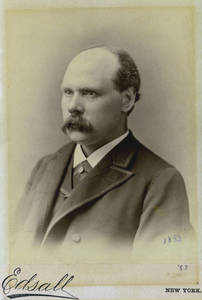Robert R. McBurney, c. 1883
Item Information
- Title:
- Robert R. McBurney, c. 1883
- Description:
-
A portrait photograph Robert Ross McBurney, c. 1883.
- Creator:
- West Side Gallery
- Date:
-
[1883?]
- Format:
-
Photographs
- Location:
- Springfield College Archives and Special Collections
- Collection (local):
-
College Archives Digital Collections
- Series:
- Trustee Records
- Subjects:
-
Springfield College
Springfield College--Trustees
Young Men's Christian Association of North America
McBurney, Robert Ross, 1837-1898
Mustaches
Portraits
- Places:
-
Massachusetts > Hampden (county) > Springfield
- Extent:
- 10 x 12.5 cm
- Link to Item:
- https://cdm16122.contentdm.oclc.org/cdm/ref/collection/p15370coll2/id/731
- Terms of Use:
-
Text and images are owned, held, or licensed by Springfield College and are available for personal, non-commercial, and educational use, provided that ownership is properly cited. A credit line is required and should read: Courtesy of Springfield College, Babson Library, Archives and Special Collections. Any commercial use without written permission from Springfield College is strictly prohibited. Other individuals or entities other than, and in addition to, Springfield College may also own copyrights and other propriety rights. The publishing, exhibiting, or broadcasting party assumes all responsibility for clearing reproduction rights and for any infringement of United States copyright law.
Contact host institution for more information.
- Publisher:
-
Springfield College
- Notes:
-
Under McBurney’s leadership, the association grew and moved several times into larger quarters. In 1870, the YMCA moved into its own building, designed by McBurney, to accommodate the specific membership and program needs of the Y. Over the next seven years, McBurney oversaw the development of nine more facilities as well as a dramatic increase in membership. He was an outspoken advocate of the “fourfold purpose,” incorporating physical activity as part of the Y’s mission when the idea was controversial. He developed the “Metropolitan Association” model of a semi-autonomous branch network with one central administrative authority. Robert McBurney also served in senior leadership roles for the International Committee, the precursor of today’s YMCA of the USA. One of his biographers wrote that McBurney’s influence on the YMCA movement was “profound, exceeding that of any other man.”
The handwritten caption on the verso of the photoboard reads"Robert McBurney 1883".
- Identifier:
-
SC18785




